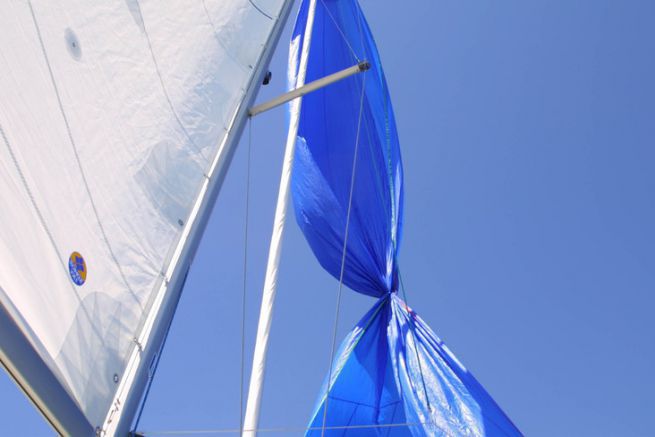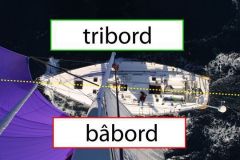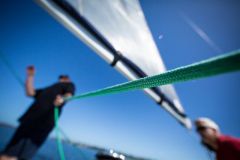If with a spinnaker, we talk about making a coconut tree, it is probably in reference to the big spinnaker pockets that swing in the wind like a tree full of coconuts.
The egg cup is almost as often mentioned in obvious reference to its curved shape and the same goes for the image of the cup bra. Our English neighbours, no less descriptive, speak of an hourglass, "?the hourglass?".
No controversy, however, because it is the portrait of the same phenomenon, a spinnaker that wraps around itself forming two large unstable pockets. And it is probably the most common spinnaker style, all the crews sailing under spinnaker have already experienced it.
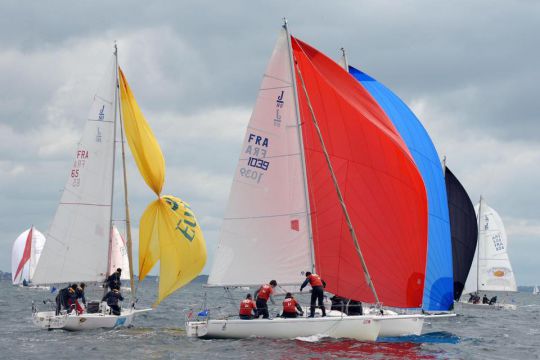
How does the spinnaker roll up on itself?
When sailing, the coconut tree most often forms when the gybe is too slow and the sheet is let out too long.
The spinnaker's leech cloth will be carried along by the swirling air behind the mainsail causing it to swell against the mainsail. The spinnaker will furl on itself until this beautiful sail looks like a rag that you twist to spin.
Take precautions when sending
The coconut tree is often already ready in its yard. It is generally a sail that is slumped loose in a bag without undoing any turns that the spinnaker may have taken during the manoeuvre.
Most of the time, coconuts can be avoided with a good bending of the spinnaker. The best is to succeed in lowering the sail without a tower in its leech. But as it is rarely the case, once inside the saloon, the spinnaker often has to be put back in its leash correctly.
We have to get out of the headboard and get the clews and tack without letting go of the edges. It's a habit to take, after each slackening, we start from the halyard stitch, follow the coloured stripes and join the 3 points together.
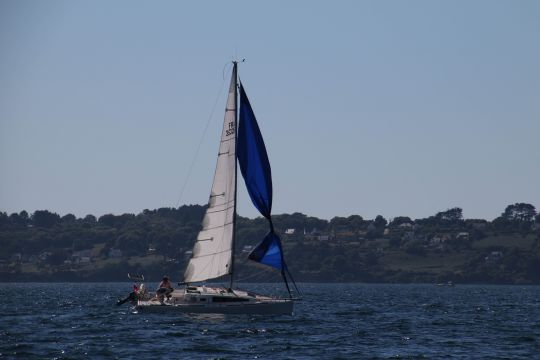
Anticipate to avoid the coconut tree
If the spinnaker makes a coconut during a manoeuvre, it will probably be at the launch, before it inflates, or during a gybe. The spinnaker is left to itself and is caught up against the eddies created behind the mainsail.
In order to avoid this problem, the first step is to limit the false failure time to the minimum necessary. Above all, we must be careful not to let the listening too much go to waste.
- When sending out the spinnaker, the sheet must be pre-bridged, just enough to ensure that the sail unfurls and is not propulsive.
- During a crewed gybe, the clew can be controlled by coordinating the shock of the old sheet and the resumption of the new sheet. This way the spinnaker will have little room to roll up on itself.
- An old spinnaker will tend to make more coconuts. Indeed, the new spinnaker cloth comes with a silicone finish that makes it slippery. As the canvas ages, the cover loses this coating and the spinnaker towers are tighter and harder to undo.

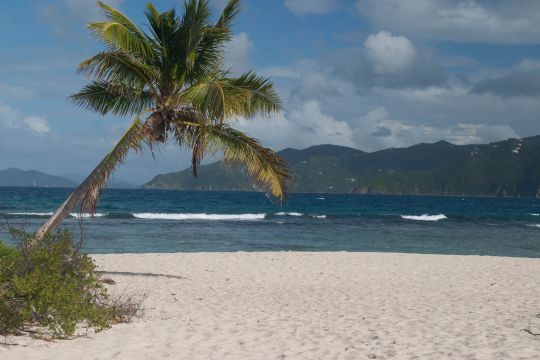
Solutions after a coconut tree
If the coconut tree appears at the time of hoisting, we have to resist the urge to pull the spinnaker sheet.
- The halyard must be stopped immediately as soon as the coconut tree is noticed.
- A crew member must hold the spinnaker cover on the front beach or better behind the mainsail to prevent it from inflating.
- It is at this point that another crew member will be able to remove the towers by following the clew along the chute. In order to do this properly, one must weigh with all one's weight, vertically, holding the leech of the sail firmly.
- If the towers are too high, ask to partially release the halyard. And the crew member continues to pull on the clew until all the turns are cleared by the rotation of the halyard.
- And if there are any recalcitrant towers, you'll have to finish the spinnaker work on the front beach.

If the spinnaker makes a coconut tree during a gybe.. there are four strategies.
- Waiting and hoping that the towers come undone. It works... sometimes, only if the towers aren't tight and you're lucky.
- If the spinnaker cloth is new enough to glide well and you can try to luff and tuck the sail so that the turns will loosen under pressure. In practice, it doesn't work that often.
- Gybe the mainsail, considering that the eddies that created the coconut tree will be able to undo this same eggcup. The eddy will be reversed as the mainsail gybes. In practice, it is generally effective.
- The last approach, but one that can be used as a first resort, is to shock the spinnaker halyard for several metres. The sail is going to be a little horizontal. The halyard will have more freedom to turn on itself, and evacuate the spinnaker towers.
If the turns are so numerous and so tight that they seem unstoppable, the sail must be lowered. Once on board, you can then remove all the towers to the last one and then fold the sail back into its bag in the proper way until the next shipment.

 /
/ 